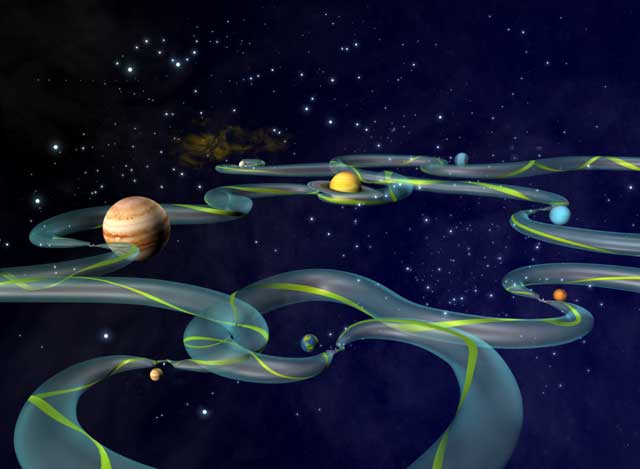
An accurate method for spacecraft navigation takes a leap forward today as the National Physical Laboratory (NPL) and the University of Leicester publish a paper that reveals a spacecraft’s position in space in the direction of a particular pulsar can be calculated autonomously, using a small X-ray telescope on board the craft, to an accuracy of 2km.
The method uses X-rays emitted from pulsars, which can be used to work out the position of a craft in space in 3D to an accuracy of 30 km at the distance of Neptune. Pulsars are dead stars that emit radiation in the form of X-rays and other electromagnetic waves. For a certain type of pulsar, called ‘millisecond pulsars’, the pulses of radiation occur with the regularity and precision of an atomic clock and could be used much like GPS in space.
The paper, published in Experimental Astronomy, details simulations undertaken using data, such as the pulsar positions and a craft’s distance from the Sun, for a European Space Agency feasibility study of the concept. The simulations took these data and tested the concept of triangulation by pulsars with current technology (an X-ray telescope designed and developed by the University of Leicester) and position, velocity and timing analysis undertaken by NPL. This generated a list of usable pulsars and measurements of how accurately a small telescope can lock onto these pulsars and calculate a location. Although most X-ray telescopes are large and would allow higher accuracies, the team focused on technology that could be small and light enough to be developed in future as part of a practical spacecraft subsystem. The key findings are:
– At a distance of 30 astronomical units – the approximate distance of Neptune from the Earth – an accuracy of 2km or 5km can be calculated in the direction of a particular pulsar, called PSR B1937+21, by locking onto the pulsar for ten or one hours respectively
– By locking onto three pulsars, a 3D location with an accuracy of 30km can be calculated
This technique is an improvement on the current navigation methods of the ground-based Deep Space Network (DSN) and European Space Tracking (ESTRACK) network as it:
– Can be autonomous with no need for Earth contact for months or years, if an advanced atomic clock is also on the craft. ESTRACK and DSN can only track a small number of spacecraft at a time, putting a limit on the number of deep space manoeuvres they can support for different spacecraft at any one time.
– In some scenarios, can take less time to estimate a location. ESTRACK and DSN are limited by the time delay between the craft and Earth which can be up to several hours for a mission at the outer planets and even longer outside the solar system.
Dr Setnam Shemar, Senior Research Scientist, NPL, said: “Our capability to explore the solar system has increased hugely over the past few decades; missions like Rosetta and New Horizons are testament to this. Yet how these craft navigate will in future become a limiting factor to our ambitions. The cost of maintaining current large ground-based communications systems based on radio waves is high and they can only communicate with a small number of craft at a time. Using pulsars as location beacons in space, together with a space atomic clock, allows for autonomy and greater capability in the outer solar system. The use of these dead stars in one form or another has the potential to become a new method for navigating in deep space and, in time, beyond the solar system.”
Dr John Pye, Space Research Centre Manager, University of Leicester, concludes:
“Up until now, the concept of pulsar-based navigation has been seen just as that – a concept. This simulation uses technology in the real world and proves its capabilities for this task. Our X-ray telescope can be feasibly launched into space due to its low weight and small size; indeed, it will be part of a mission to Mercury in 2018. NPL’s timing analysis capability has been developed over many years due to its long heritage in atomic clocks. We are entering a new era of space exploration as we delve deeper into our solar system, and this paper lays the foundations for a potential new technology that will get us there.”
Learn more: “GPS in space”: NPL and University of Leicester bring autonomous interplanetary travel closer to reality
The Latest on: Autonomous interplanetary travel
[google_news title=”” keyword=”autonomous interplanetary travel” num_posts=”10″ blurb_length=”0″ show_thumb=”left”]
via Google News
The Latest on: Autonomous interplanetary travel
- A Remarkable New Thruster Could Achieve Escape Velocity—and Interplanetary Travelon May 3, 2024 at 4:30 am
Ion thrusters are the most common primary engine powering satellites through orbital maneuvers today. But to travel from low-Earth orbit (LEO) to farther orbits—or even the Moon—requires a different ...
- 11 Best Travel Insurance Companies Of May 2024on May 2, 2024 at 7:52 am
Michelle is a lead editor at Forbes Advisor. She has been a journalist for over 35 years, writing about insurance for consumers for the last decade. Prior to covering insurance, Michelle was a ...
- DARPA's autonomous 'Manta Ray' drone can glide through ocean depths undetectedon May 1, 2024 at 4:00 am
Northrop Grumman Corporation has built its Manta Ray uncrewed underwater vehicle, which will operate long-duration missions and carry payloads into the ocean depths in partnership with DARPA.
- Travel Medical Insurance: Emergency Coverage For International Travelon April 29, 2024 at 5:00 pm
International travel medical insurance is a type of insurance that can help cover the cost of medical care abroad. If you’re on vacation and suffer a sudden injury or illness, you may need to ...
- New stealthy submarine glider set for autonomous undersea missionson April 24, 2024 at 3:00 am
The ocean depths are a new frontier explored by humans and autonomous vehicles. Leading the charge is Northrop Grumman's innovative Manta Ray uncrewed underwater vehicle (UUV), a technological ...
- People are afraid of self-driving cars — can the industry change that?on April 16, 2024 at 1:00 pm
The autonomous vehicle industry’s main lobbying group — yes, of course it has one — is intent on reversing this trend before it gets much worse. The Autonomous Vehicle Industry Association ...
- Autonomous driving startup Ghost Autonomy gives up the ghoston April 3, 2024 at 8:21 pm
The autonomous driving software startup Ghost Autonomy Inc., which had raised almost $220 million in venture capital funding, has given up the ghost and closed its business. The startup posted a ...
- autonomous droneon September 27, 2023 at 5:00 pm
Even with all the technological advancements in recent years, autonomous systems have never been able to keep up with top-level human racing drone pilots. However, it looks like that gap has been ...
- Autonomous promo codes & couponson March 25, 2023 at 6:27 pm
Kailen Locke has been a part of the L.A. Times Commerce team for three years. With a background in marketing and passion for media, Kailen enjoys immersing herself in the arts whether it’s ...
- Autonomous Carson September 14, 2022 at 8:48 am
From Tesla to Google to Uber to all the major automakers, we bring you complete coverage of the race to develop fully autonomous vehicles. This includes helpful explanations about the technology ...
via Bing News










